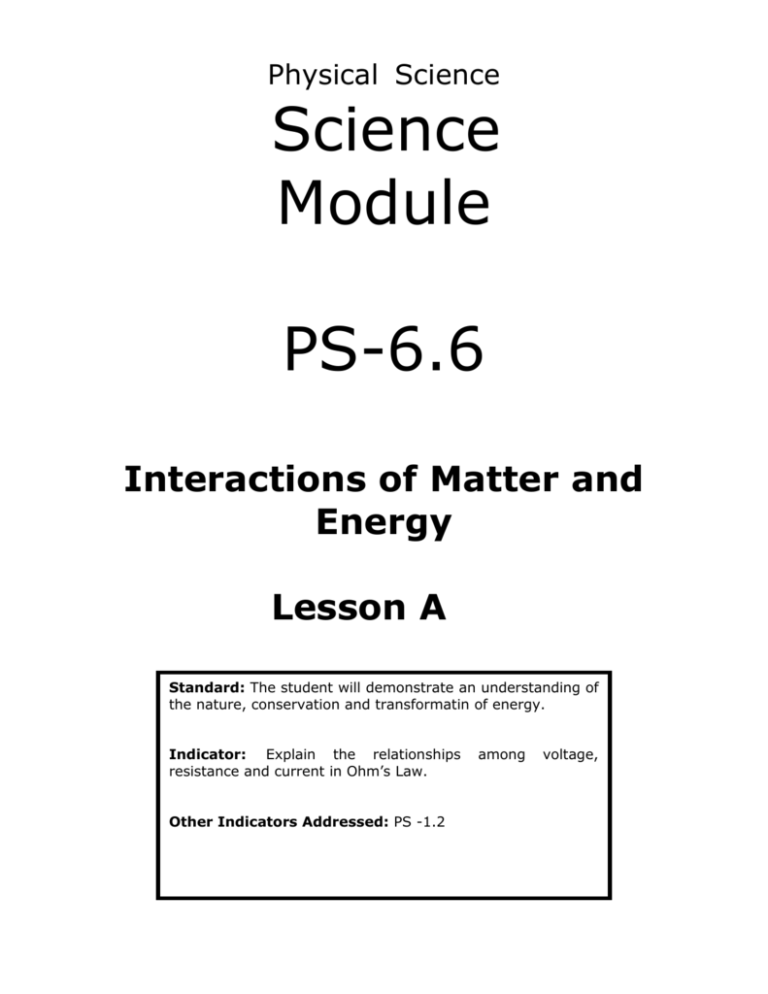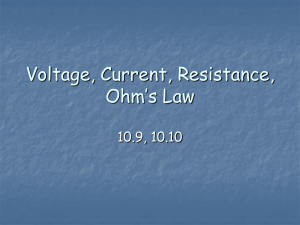PS 6.6 - S2TEM Centers SC
advertisement

Physical Science Science Module PS-6.6 Interactions of Matter and Energy Lesson A Standard: The student will demonstrate an understanding of the nature, conservation and transformatin of energy. Indicator: Explain the relationships resistance and current in Ohm’s Law. Other Indicators Addressed: PS -1.2 among voltage, Instructional Progression: In the 4th grade students summarized the functions of the components of complete circuits (including wire, switch, battery, and light bulb) (4-5.6), and also illustrated the path of electric current in series and parallel circuits (4-5.7). In the 6th grade students illustrate energy transformations (including the production of light, sound, heat, and mechanical motion) in electrical circuits (6-5.4). In Physical Science students will expand their concepts of the relationships among current, voltage, and resistance in the context of Ohm’s law. Taxonomy level of indicator: 2.7-B Explain Conceptual Knowledge Key Concepts: Voltage Resistance Current Ohms law Volt Ohm Ampere Content Overview: It is essential for students to understand that Voltage is electric potential energy per charge. It provides the energy that pushes and pulls electrons through the circuit. o Voltage is measured in volts. The symbol is (V). o Voltage is created by: a chemical cell when it changes chemical energy to electrical energy, or by a generator when it changes mechanical energy to electrical energy, or by a solar cell when it changes light energy to electrical energy. When a wire connects the terminals of a battery or generators, then the voltage will push and pull electrons through a conductor. o One terminal has extra electrons thus a negative charge. The other terminal has a deficit of electrons and thus a positive charge. o Electrons in the wire are pushed by the negative terminal and pulled by the positive terminal through the wire. Electric current is the flow of charge through a conductor. ○ ○ The electric current in a wire is the flow of electrons. Electric current is measured in amperes or amps. The symbol is (A). Electric resistance opposes the flow of charge through a conductor. All conductors have some resistance to an electric current with the exception of some superconducting materials at very low temperatures. o In wires, resistance occurs when the electrons flowing through the wire continually run into metal atoms and bounce around. These collisions impede the flow of the electric current and change some of the electrical energy to thermal and/or light energy. o Resistance is measured in ohms. The symbol is ( ). o Resistance will reduce the flow of current because it is harder for the current to get through the conductor. When an electric current encounters resistance heat is produced. Wires that have a larger diameter have less resistance. Longer wires have greater resistance. In many materials an increase in temperature will increase resistance Teaching Lesson A: Resistance and Ohm’s Law Investigation Introduction to the lesson: Investigate Ohm’s Law and discover what conditions maximize current flow. Lesson time: 0.50 day Materials Needed: Computer with Internet Access Essential Question: What factors affect Resistance in an electrical circuit? Procedure: I. Resistance Sim 1. Goto http://phet-web.colorado.edu 2. Click Simulations, Electricity, magnets, and circuits 3. Select Resistance in a Wire A. Manipulate each button separately and in your own words what does each variable represent(look at what changes) 1. P(Greek letter rho) 2. L 3. A B. Discuss these variables with another Group. Do you agree with what each represents? Make any corrections if needed. C. In this simulation what factor(s) increase resistance? D. What other factor(s) not shown in this simulation might also increase resistance? (Think about reading and class discussion). II. Ohms Law Sim 1. Close the Resistance in a Wire Sim 2. Open the Ohm’s Law Sim A. From this Sim explain what each variable represents and give its units 1. V 2. I 3. R B. Manipulate the buttons. What conditions maximize current? C. What conditions minimize current? D. Close the program and log out. Assessing the Lesson: Formative Assessment Questions: 1. Predict what will happen to the current in a circuit if the voltage is kept constant but the wire diameter is increased. 2. Predict what will happen to the current in a circuit if the voltage is kept constant but the wire length is increased. 3. Predict what will happen to the current if the resistance is unchanged but the voltage is increased. b. the voltage is decreased? 4. Predict what will happen to the resistance if you change from a copper wire, which is a good conductor, to an iron wire, which does not conduct as well. Assessment 1 EOC Type Questions 1. What will happen in a complete circuit if the current is increased but the voltage remains the same? A. The resistance will also increase. B. The resistance will remain the same. C. The resistance will decrease. D. The current cannot be changed. 2. What will happen to the voltage in a circuit if the resistance is increased and the current is kept constant. A. The voltage cannot be changed in a circuit. B. The voltage is increased. C. The voltage is decreased. D. There is no effect on the voltage. 3. How are the voltage and the current in a closed electrical circuit related. A. directly B. indirectly C. constantly D. independently 4. With A. B. C. D. 5. If the voltage in an electric circuit is kept constant and the resistance is doubled, what will happen to the current? A. The current is also doubled. B. The current is cut in half. C. The current is reduced by one fourth. D. The current is increased by one fourth. Answers 1. 2. 3. 4. 5. what relationships does Ohm’s Law deal? current and voltage current and resistance voltage and resistance voltage, current and resistance C B A D A Content Area: Science SOUTH CAROLINA SUPPORT SYSTEM INSTRUCTIONAL GUIDE Science Inquiry Skills-These standards should be addressed during the first few weeks of school and revisited throughout each unit. Physical Science Recommended Days of Instruction: .5 (one day equals 90 min) Standard(s) addressed: PS–6 The student will demonstrate an understanding of the nature, conservation, and transformation of energy. Energy Transformation Indicator PS–6.6 Explain the relationships among voltage, resistance, and current in Ohm's law. Recommended Resources SC Science Standards Support Guide https://www.ed.sc.gov/apps/cso/sta ndards/supdocs_hs.cfm? Adopted Physical Science Textbook (see appendix for correlations) ETV Streamline SC Video Electricity and Magnetism: Current Electricity Current, voltage and resistance are all terms used to describe and measure electricity. ETV Streamline SC Static and Current Electricity Experiments in Exploration, Arizona State University http://acept.la.asu.edu/courses/phs1 10/expmts/toc.html Suggested Instructional Strategies Module 6-6 Lesson A Ohm’s Law Simulations & Contributions http://phet.colorado.edu/new/index.phy Assessment Guidelines Assessment 1 EOC Type Questions The objective of this indicator is to explain the relationship among voltage, resistance, and current in Ohm’s law, therefore, the primary focus of assessment should be to construct cause and effect models showing these relationships. In addition to explain, assessments may require that students Compare the concepts of voltage, current, and resistance; Summarize major points about voltage, current and resistance; Infer what will happen when one of the variables changes. Indicator Recommended Resources DSMST Dearborn Public Schools http://www.physicslessons.com The School for Champions http://www.school_for_champions.co m/science.htm Interactive Gizmos http://www.explorelearning.com The Kavli Operating Instuitute http://www.colorado.edu/physics/phet /web-pages/index.html Suggested Instructional Strategies Assessment Guidelines





